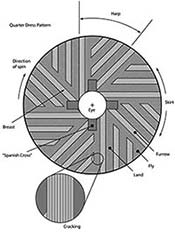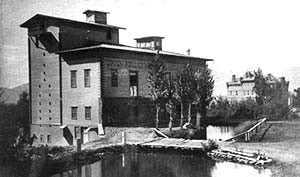Early Industries ~ Index
Establishment of the first early mills in Cache Valley.

Being so far away from the markets and manufacturing centers and with no railroad transportation, the early settlers were compelled by natural conditions and circumstances to be resourceful and build up home industries. As houses were among the first things needed, naturally immediate efforts were put forth to find the easiest way to get the logs and saw them into lumber. In the summer of 1859, James Ellis and Benjamin Williams built a saw pit where the present building of the Thatcher Milling and Elevator Company is located. They operated an upright or whip saw, by hand, during that summer and the winter of 1860. Most of the logs were cut in Green Canyon and hauled to the Ellis and Williams Mill. The saw was operated by one man standing above the log and another man under the log in a pit and the saw was drawn up and down through the log and sawed it up in the proper thickness. This was rather slow and hard work.
The settlers soon saw the possibilities of water power by building a canal on the north rim of the river basin, so in the early spring of 1860, Hezekiah Thatcher, Joel Ricks, and Ezra T. Benson started a canal know as the Mill Race and took in the Little Logan River. This canal was brought along the rim of the river basin to where the Ellis and Williams saw pit was and here a wooden (water) wheel was installed and a sawmill and gristmill combined was constructed and used the same water power. A circle saw was put in and the logs were sawed much easier and faster than with the whip saw. Later, as a result of the building of the temple and tabernacle and other public buildings, several industries were developed.

A sawmill was built in Temple Fork (Canyon) in Logan Canyon and nearly all the lumber used in the construction of the Logan Temple was sawed at this mill. Much lumber was sold besides and the proceeds went to help build the temple. A large lime kiln was also constructed near the present intake of the Utah Power and Light Company in Logan Canyon and from it all the lime for the building of the temple and tabernacle was secured. It also brought in considerable revenue by the sale of lime elsewhere.
The gristmill built in 1860 in connection with the sawmill, was one of the first in the valley. In a short time the milling interest grew to such an extent that the sawmill had to be abandoned and the flour-mill was rebuilt on a much broader scale on its present site, in 1865 under the name of Thatcher and Sons Union Roller Mills.
The first flour mills in the valley used millstones to grind the grain. These were made in Salt Lake City by a Mr. Mitchell and had to be taken from a hard and cellular siliceous stone. These were secured at Black Rock, west of Salt Lake City. However, a number were imported and were called the French Buhr. They came from France and had the best qualities of any millstones. The millstones consisted of two flat cylindrical stones enclosed with a wooden or white metal case. The lower stone or bed stones, was permanently fixed while the upper or runner was accurately pivoted and balanced over it. The average size was about three to four feet in diameter and about twelve inches in thickness. They were generally built up of segments, bound together around the circumference by an iron hoop and backed by plaster paris.
The bed stone was dressed to a flat surface and a series of groves or shallow depressions were cut into it. The groves meeting each other operated like a rough pair of scissors and the effect was cutting, squeezing and grinding the grain. The upper stone or runner passed in motion by a spindle on which it was mounted and the spindle passed up through the center of the bed stone. There were screws and other appliances for adjusting and balancing the runner. Further provision was made for the passing of air to prevent too high a heat being developed in the grind operation. There were small sweepers to convey the flower to the meal spout, after which the meal was carried to a flour dressing machine and was passed through wire or silk cloth of different degrees of fineness.
With the development of the valley, the demand for the flour of the Thatcher and Sons Union Roller Mill became so great that in 1879 it was overhauled and refitted throughout with entirely new machinery and was still the best mill in the valley. In 1885 the market for the product had widened to such an unusual extent that the mill was again remodeled at a great outlay into a roller mill and the millstones were discarded. In 1888 a large elevator with a capacity of 40,000 bushel was added. This was one of the largest elevators in the Territory at that time and was a great help to the farmers as they could dispose of their wheat when they needed the money. The mill had a daily capacity of 1,100 barrels and its product was sold in the markets of Idaho, Wyoming, Montana, Colorado, Nebraska and Arizona and all the principal points in Utah. It is now known as the Thatcher Milling and Elevator Company and is still one of the leading flour-mills of the state.

Due to the increasing demand for mill products, the Deseret Mill was constructed in 1868 by Mr. Thomas E. Ricks of Logan and William Hendricks of Richmond. At that time it was considered a very substantial building and later was well equipped with good machinery and had quite an extensive trade. Mr. N.M. Hansen was the first miller and remained as miller for more than twenty years. The building still remains and is located on the Logan Canyon road between First and Second East streets.
Mr. Charles O. Card with others also constructed one of the early gristmills and located it where the present building of the Central Milling and Elevator Company is. With the rapid improvements made in milling machinery and processes, this mill soon became obsolete and a new company known as the Central Milling and Elevator Company was organized with William B. Preston as president. A new building was erected and the roller type of machines and other modern improvements for those days, were installed, Mr. John R. Burns was the first miller and his mill products commanded a ready sale.
In the spring of 1860, Thomas Weir and Joel Ricks built a tannery where the present building of the Farmers' Equity stands on South Main street. A large stone wheel about five feet in diameter and notched around the outer edge, was used to crush the red pine bark obtained in Logan Canyon. The wheel was turned by a horse hitched to a pole and pulling in a circle. The crushed bark with the hides were allowed to soak in vats of water for two or three weeks and lime was added to the solution to loosen the hair. After this process and the hides were curried, they were tanned and made into leather. It was a slow and tedious process but under the circumstances with the crude equipment, a good leather was manufactured from which George Hubbard and Mr. Davidson did the shoe repairing and made boots and shoes.
Charles O. Card and Cyrus Card built a small sawmill where the former site of the Anderson Lumber mill was located. A Mr. Peterson built a small planning mill just across the street from the Card mill. Much of the early furniture used locally as well as in the other settlements of the valley, was made by Mr. Peterson. Later Messrs. Graff and Haynes constructed a planning mill on the millrace just opposite the present depot of the Interurban Railway Company. Here they manufactured boxes, window sashes, doors and other articles for the entire valley.
Mr. Livingstone built a carding mill near the present site of the Deseret Mill and all the wool raised in Logan and the nearby settlements was brought here to be carded.